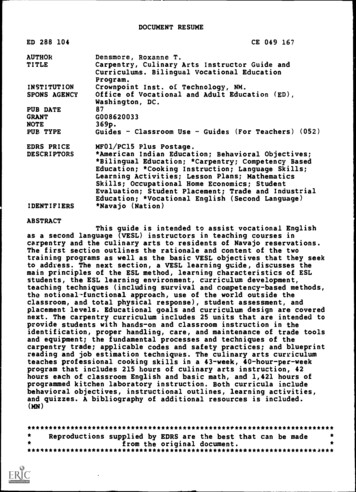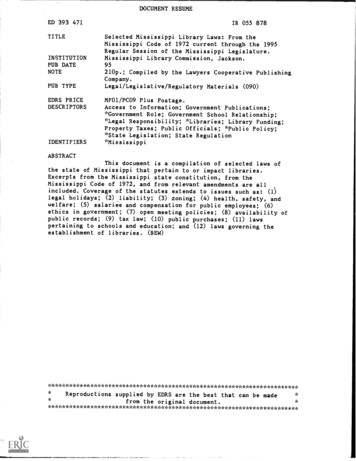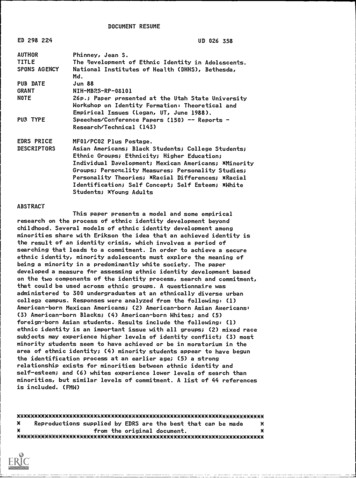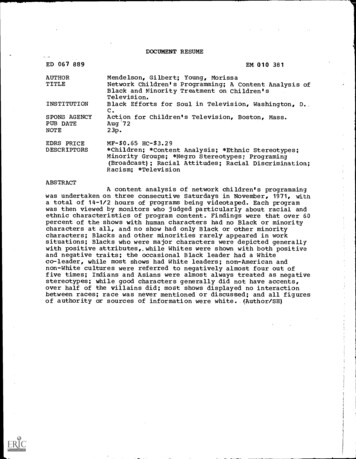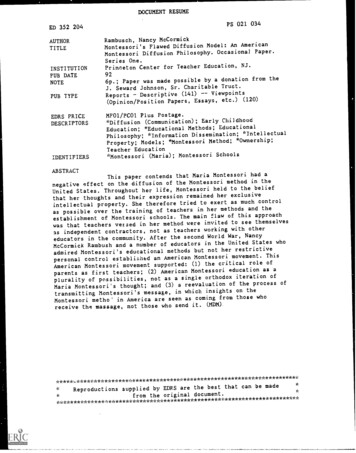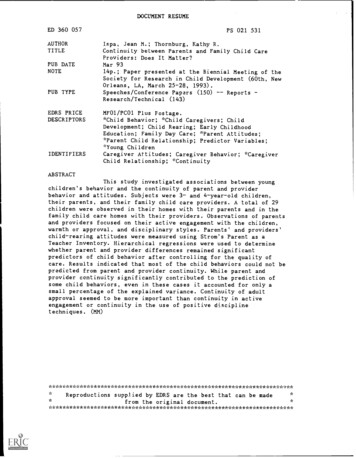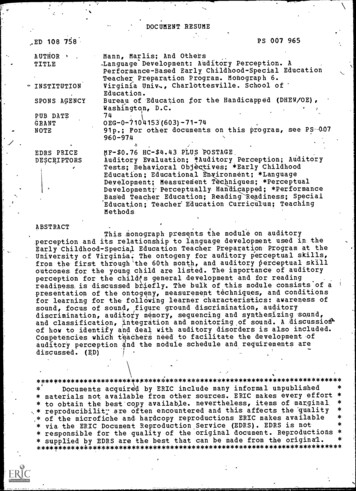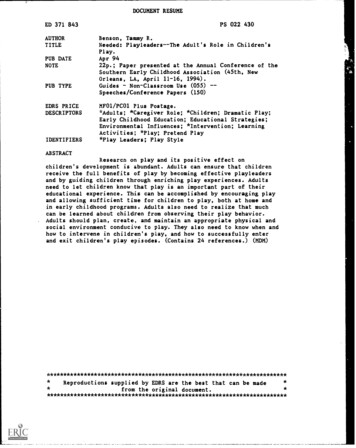
Transcription
DOCUMENT RESUMEPS 022 430ED 371 843AUTHORTITLEBenson, Tammy R.Needed: Playleaders--The Adult's Role in Children'sPlay.PUB DATENOTEPUB TYPEEDRS PRICEDESCRIPTORSIDENTIFIERSApr 9422p.; Paper presented at the Annual Conference of theSouthern Early Childhood Association (45th, NewOrleans, LA, April 11-16, 1994).Guides - Non-Classroom Use (055) -Speeches/Conference Papers (150)MF01/PC01 Plus Postage.*Adults; *Caregiver Role; *Children; Dramatic Play;Early Childhood Education; Educational Strategies;Environmental Influences; *Intervention; LearningActivities; *Play; Pretend Play*Play Leaders; Play StyleABSTRACT.Research on play and its positive effect onchildren's development is abundant. Adults can ensure that childrenreceive the full benefits of play by becoming effective playleadersand by guiding children through enriching play experiences. Adultsneed to let children know that play is an important part of theireducational experience. This can be accomplished by encouraging playand allowing sufficient time for children to play, both at home andin early childhood programs. Adults also need to realize that muchcan be learned about children from observing their play behavior.Adults should plan, create, and maintain an appropriate physical andsocial environment conducive to play. They also need to know when andhow to intervene in children's play, and how to successfully enterand exit children's play episodes. (Contains 24 references.) **************************Reproductions supplied by EDRS are the best that can be madefrom the original ******************************
aU.S. OEPARTMENIT OF IEDUCATOON0Mice ot Educattorma Rs/march and imotovimn(EDUCATIONAL RESOURCES INFORMATIONCENTER (ERIC)Xihts docunmnI Am Wen roproducard'coward Iron Me parson or orgaruzattonOngrnatong it0 Minor changes nave bean mad* to ImprovePlay - 1naPrOduction QuantaPO011 CO vow or oramons statad tn thdtdocu-mint do not nacessartly rapromtnt othoalOERI pOttreon or pottcyNeeded: PlayleadersThe Adult's Rolein Children's PlaySubmitted by:Tammy R. BensonDepartment of Childhood EducationUniversity of Central Arkansas(1.1)P. O. Box 4913Cf,Conway, Arkansas 72032Ph. (501) 450-5462C\1"PERMISSION TO REPRODUCE THISMATERIAL HAS BEEN GRANTED BY(1111)--C-CkVVCINbiZ.,t1Sb2BEST COPY AVAILABLENC%TO TH E EDUCATIONAL RESOURCESINFORMATION CENTER (ERIC)."
Play - 2IntroductionResearch is abundant when it comes to play and its positive effect onchildren's development. Isn't it exciting that something children naturallyengage in can reap them such extraordinary benefits in all areas ofdevelopment? Play is enjoyable for all but often underestimated for its uniqueway of positively influencing physical, cognitive, and psychosocial development.Children especially can become consumed in the magnificent world of play.This world of play offers a child vast opportunities to learn about themselves,others, and the environment in which they live.Today experts agree that play is beneficial to children and their overallhealthy development. Adults are encouraged by the recognition that thequality of children's play is related to their acceptance by peers (Hughes,1991). This conveys the fact that children need play to help them sociallyinteract with their peers, which is a critical lifelong skill. Wolfgang (1981)confirms the importance of play for social, emotional, intellectual, and physicaldevelopment. Through dramatic play, children learn to assert themselves ina way to build their competence in later adult roles (Elkind, 1987).Developmental psychologists, such as Piaget and Sutton-Smith, consider playas specific behaviors involving divergent3
Play - 3thinking (Kleiber & Barnett, 1980). These are only a few of the widelyrecognized professionals who acknowledge the vast benefits of play, especiallysociodramatic play.Realizing the magnitude of play in a child's development, what canadults do to ensure that children receive the full benefits of play? What thingsmust an adult know and do to foster a playful spirit in children that results inhigh levels of sociodramatic play? How can adults lead children through theappropriate avenues that promote higher level thinking skills involved in play?This article intends to give adults ideas and suggestions for becomingplayleaders, thus gu;cling children through years of successful play, resulting inyears of healthy growth and development.To accomplish this task, caregivers must focus en the value of play,observe and learn from play, allow sufficient time for r ay, plan appropriatephysical and social play environments, as well as know when and how tointervene in play episodes. The final section of this article gives results ofadult interventions and how they have affected children's play. Though allplay is valuable, this article's focus will be on sociodramatic play, which is ahigh and mature level of play. The emphasis remains on adult involvementwhich can positively affect play.4
Play - 4Value of PlayThe Association for Childhood Education International has stated thatplay is a natural behavior that is related to children's development and thatno adult instruction can take the place of children's own activities andexperiences through continual play (Isenberg & Quisenberry, 1988).Bredekamp (cited by Frost, 1992) acknowledges child-initiated, child-directed,and teacher-supported play as a valuable element of developmentallyappropriate practice. When viewing the rese sell, it's obvious the manypositive results that appear from children's involvement in play, Recently, thevalue of play is increasing in its regard to positively shaping children's lives.Smilansky (1968) pioneered the idea of a positive correlation betweenchildren's sociodramatic play and their success in school. Her study was oneof the first that began to tutor low socioeconomic children to play in hopesthat theywould make academi, nogress. She found children who were unsuccessfulwith sociodramatic play tended to have parents with little or no formaleducation.These children came from environments where play wasdiscouraged as being unrealistic. From her study, she encourages adults tovalue play by providing a context where the play can be supported.
Play - 5When deciding whether to intervene, adults let children know whattheir attitudes are about play. Children realize how adults feel about play byadult actions and words. If they themselves cannot be playful, then childrenmay not recognize the value of play. Johnson, Christie, & Yawkey (1987)conclude that adults let children know play is worthwhile by showing aninterest in their play and at times being an active participant in play.After realizing the value of play, the next step is to share thatinformation with other adults. It is up to educators, parents, and othersconcerned with children's development to broadcast the benefits of play.Christie & Wardle (1992) stressed the importance of working with parents onunderstanding that play is not "just play" but has extensive educational value.There is an immense responsibility to spread the news about the relevancy ofplay in children's healthy development.Observing PlayHow can play be examined if time is not taken to observe play inprogress?"Play is a wiLidow on a child's understanding of the world(Bowman, 1990, p. 105)." If adults would take time out to sit, listen, andreally observe a child engaged in sociodramatic play, exciting discoveries couldbe made about
Play - 6that child and his/her perceptions of life. Bowman (1990) adds that byobserving play, adults can have an alternative to spoken language. Oftenobservers of play hear things the child wants to say but may not be able toexpress. Emphasis needs to be given to observation so adults can gain closerinsights into possible difficulties a chikl may be experiencing (Si nilansky, 1968).These insights could make a major difference in our abiStv to structure anappropriate play environment for the child.Griffing (1983) emphasizesanswering certain questions while observing the child's play to heightenawareness of children's individual play styles and development. She suggestsasking questions about the content of the play, the verbal interaction, types ofpretend episodes, social context of dramatic play, and the duration of play.Answers to these questions bring adult awareness of children's individualdevelopment and needs to a higher level.There are several scales that can be used for observing and identifyingplay behaviors in children. The Parten/Piaget scale is used to categorize playsocially and cognitively (Johnson, Christie, & Yawkey, 1987). When lookingat sociodramatic play, Smilansky's (1968) Sociodramatic Play Inventorydeserves attention. This inventory allows the observer to identify the maturitylevel of the play. There are
Play - 7six crucial elements involved in successfully engaging in sociodramatic play.They include imitative role play, make believe in regard to objects, makebelieve in regard to actions and situations, persistence, interaction with others,and verbal communication (Smilansky, 1968). Observing these elements ismeaningful to the observer in that they can focus on the missing elements.Before intervention can be made successfully, it is undoubtedly wise to be anastute observer.To improve observational skills, adults may keep an anecdotal recordof each child in play for 5-10 minutes over a week (Blalock & Hrncir, 1980).Record keeping such as this better focuses observational time. It's importantto continue record keeping since observational skills improve with practice.Time for PlayWhen striving for a balance among the diffe:ine; aspects of a youngchild's curriculum, play cannot take a back seat to other academic areas. Asthe testing and back-to-basics movements push toward skills, worksheets, andtextbooks, play time can get minimized to the point of little or no play. It hasbeen found that larger amounts of play time can produce higher achievementscores for children (Glickman, cited by Blalock & Hrncir, 198j). Christie &Wardle's (1992) findings
Play - 8conclude that longer play periods encourage children to engagein higher social and cognitive forms of play. On the other hand, shorterperiods reduce the amount and maturity of children's play.Frost (1992)recommends at least 30-50 minutes for four and five year old children,increasing that time to one hour of free play for kindergartners. He stressesthat given an appropriate environment and freedom from adult intrusion,children's dramatic play seems to increase in intensity.Considering the complexity of sociodramatic play, it makes sense thatchildren would need appropriate time to recruit co-players, select roles, findprops, play story lines, work out differences, talk over ideas, and carry outdramatizations. Johnson, Christie, & Yawkey (1987) suggests that if you'reshort of time, it's preferable to have a few, long sessions of play in a weekrather than daily, short sessions.Appropriate Physical EnvironmentAs adults observe and learn from play and provide ample time for play,it becomes obvious the increasing influence of the physical environment. Isit conducive to play? How can more involvement in play result from thephysical restraints of the environment? Rogers & Sawyers (1988) give oneof the first requirements of the environment in that it be safe but without9
Play - 9unreasonable physical and verbal restrictions.Once assured of a safeenvironment, then creation of an optimal play environment can begin. Whenworking on this optimal physical environment, it need not be sterile or nonchanging, which will limit the children's involvement (Frost, 1992).One of the first items to consider is the use of space. To provideadequate space, consideration must be given to the number of children, theirage and developmental level, type and range of play themes, materials andequipment available, and time allotted for play (Frost, 1992). If limited spaceis a problem, remember the outdoors could easily be an extension to theclassroom. Materials and equipment should be set up outside to extend theplay environment. Benefits are inevitable if you inwgrate play indoors andoutdoors.Other items needed for an optimal environment would be appropriatematerials and equipment.Play materials influence children's play behavioras well as different forms of play (Brown & Briggs, 1990). Wolfgang (1981)suggests a variety of materials ranging from fluid (hardest to control) to morestrxtured (easiest to control). This accounts for individual abilities andlearning styles. A wide variety of toys need to be offered that provide sensorystimulus and feedback (Rogers & Sawyers, 1988). Children are very creativein using all kinds of materials in their pretend play sessions. However, to10
Play - 10encourage sociodramatic play, include large, moveable materials, such ascardboard boxes, telephone spools, and hollow blocks (Frost, 1992). Alwaysselect creative and imaginative materials that are stimulating to children.What materials would be best for encouraging dramatic play? Dodge& Frost (1986) found that thematic props were especially useful for promotingsociodramatic play. They also found that creative playgrounds with moveableequipment and action oriented themes were most popular during play. Thisstudy also verified the dependence of younger children on more realisticprops, declining in importance in later years. It would be advisable to providetoddler and preschool classrooms with more realistic props. Proper settingscontinue to affect children's development of sociodramatic play. Much time,planning, and attention is needed to provide a setting that promotes higherdevelopments of play.Manipulating certain environmental variables can modify play behaviorsin young children (Teets, 1985). Teets (1985) gives several suggestions fromher studies that improve classroom organization for play. These includekeeping clear paths throughout the environment, considering where to putspecific interest areas, making clear definitions of interestareas with boundaries, displaying materials for self-selection by students, andleaving 1/3 to 1/2 of your floor space for free play space. One other aspect11
Play - 11of the environment is to create complexity which keeps children's interest levelhigh (Teets, 1985).From these studies, one can't underestimate the powerof the physical environment to enhance play bringing it to a higher level anda longer duration.Positive Social EnvironmentTo provide favorable opportunities for play, there first needs to be aplayful atmosphere. Parents and educatorsi eed to establish an environmentthat encourages a sense of freedom in children. Children need to feel theyhave some control over ',13at happens around them. Rogers & Sawyers (1988)found that appropriate choices should be given to children to achieve thisplayful atmosphere. When children are allowed to make these decisions, theyexperience the freedom and intrinsic motivation associated with play andleisure (1eiber & Barnett, 1980). As an adult promoting play, direction andintrusion would need to be limited to assure children the opportunity to assertthemselves and avoid a feeling of vulnerability.To ensure a positive social environment, make sure that children havehad adequate experiences to be able to play. Providing a broader base ofexperiences for children to be able to express themselves through play isrecommended (Isenberg & Quinsenberry, 1988). Field trips, quality literature,television and other media can provide an avenue for these experiences.12
Play - J2When using themes inclassroom, it would be necessary for children to befairly familiar with the theme. Children may experience frustration if they areless familiar with the roles they are attempting to play. Adults must makesure children are exposed to a variety of stimuli that familiarizes children withthe theme being used (Woodard, 1984).While allowing for individual choices and providing appropriateexperiences, three other major areas of the social environment must beconsidered. These include are significant others, comm;mity institutions andorganizations, and inventions and creations (Aguilar, 1985).The significantothers would include family members, friends, teachers, and others in a child'sdaily experiences.They can affect play by modeling playfulness, givingchildren a sense of freedom, and giving children opportunities to expressthemselves in their own unique way. Community resources include theschool's attempt to put excessive control on children, which inhibits play andcreativity.'*her resources might include amusement parks which promoteplay through various ways. Last, the inventions and creations are attempts toamuse the society in general.Computers and video games are primeexamples. The most successful inventions for children are those that allowmanipulation, challenge, and variety (Aguilar, 1985).Aguilar (1985) also gives some interesting recommendations for13
Play - 13creating a playful atmosphere.She suggests providing outlets for self-expression, encouraging children to "play with" ideas, providing risks andchallenges,incorporating the arts, being flexible,encouraging anddemonstrating good humor, and allowing for fantasy and imaginativebehaviors. All of these suggestions increase the chance that children willrespond in a positive way. Once children see their ideas are valued as partof the class, they are more likely to engage in playful behaviors. Othersuggestions for creating an environment supportive of sociodramatic playinclude being supportive (not forceful) of pretend play, turning control of theplay over to children, resisting temptation to direct play, acting playful, andbeing the constant encourager of children's involvement (Rogers & Sawyers,1988).When realizing the responsibility adults have in creating a positive,playful social environment, barriers to this process must be addressed. Somebarriers are the inflexibility of rules, norms, and social expectations (Aguilar,1985). Aguilar (1985) also notes that propaganda and advertisements havetheir own way of forcing a social control upon all adults and children alike.When adults feel under the constant scrutiny of the social environment, theyare less likely to "let loose and play." The need for social approval should belimited to create a positive, fun atmosphere where children are willing to take14
Play - 14chances and try new challenges through play (Aguila, 1985).Play InterventionShould adults ever interfere in children's sociodramatic play? Shouldchildren be allowed to direct their own play? Can one answer yes to bothquestions? When dealing with these questions, the first problem is knowingwhen and if intervention is necessary in children's play. The next problem isfocusing on the quality and the quantity of intervention in children's play.When adults decide to intervene, what are the best methods and techniques?How would adults intervene to encourage play rather than inhibit play?First, there tends to be some discrepancies on the extent to whichadults should intervene in children's play. Frost (1982) believes there aretimes when children should play without any intervention, but when childrenhave difficulty, adults should offer encouragement and support. Smilansky(1968) takes adult involvement a key steps father. She feels very strongly thatadults should take an active part in aiding children's development of higherforms of play. Her research shows that children will not make progress intheir play if only given facilities and an inviting atmosphere. Thus adults needto take a more active role.Other researchers will dispute this direct role of adults. They tend toagree that if adults guide the play continuously, it ceases to be play (Frost,15
Play - 151982). Wolfgang (1981) supports the notion that adults usually do not belongin the child's w
DOCUMENT RESUME ED 371 843 PS 022 430 AUTHOR Benson, Tammy R. TITLE Needed: Playleaders--The Adult's Role in Children's. Play. PUB DATE Apr 94. NOTE. 22p.; Paper presented at the Annual Conference of the. Southern Early Childhood Association (45th, New Orleans, LA, April 11-16, 1994). PUB TYPE Guides - Non-Classroom Use (055) --Speeches .



